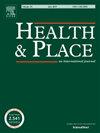Impact of neighborhood income inequality on adolescents' mental health. Results from the STARS study
IF 3.8
2区 医学
Q1 PUBLIC, ENVIRONMENTAL & OCCUPATIONAL HEALTH
引用次数: 0
Abstract
Over recent decades, there has been a simultaneous increase in income inequality and adverse mental health outcomes among adolescents in Western countries and especially in Sweden. Prior research on the relationship between income inequality and mental health has primarily focused on studies involving adults, yielding diverse findings regarding the nature of their association. Given the importance of relationships and comparisons to peers in immediate vicinity, we aimed to investigate the impact of neighborhood income inequality on mental health problems among seven-graders in Western Sweden. We used data collected in the STARS (STudy of Adolescence Resilience and Stress) cohort. A total of 1958 adolescents (mean age 13.6, SD = 0.4, 44% male) in 313 Demographic Statistics Areas (DeSO) were included. Adolescents answered questionnaires regarding stress and psychosomatic symptoms. Neighborhood income inequality was measured as DeSO-level's P90/P10 ratio, defined as the ratio between the 10th (highest) and the 1st (lowest) income decile. In a multilevel linear regression analysis, we found that higher neighborhood income inequality was related to lower stress and psychosomatic symptom scores after controlling for sex, individual parental income, and mean income and child poverty rate at DeSO-level. The associations did not differ significantly among DeSO-areas with different income or child poverty rates. Sex-specific-analysis revealed that the inverse association between income inequality and stress and psychosomatic symptoms was stronger in females than in males, but not significantly so. In summary, this study provided evidence supporting an association between higher neighborhood income inequality and reduced levels of seven-graders’ stress and psychosomatic symptoms.
邻里收入不平等对青少年心理健康的影响STARS研究的结果。
近几十年来,西方国家,尤其是瑞典,收入不平等和青少年心理健康不良后果同时加剧。之前关于收入不平等与心理健康之间关系的研究主要集中在成人研究上,对两者之间关系的性质得出了不同的结论。考虑到人际关系的重要性以及与邻近同龄人进行比较的重要性,我们旨在调查邻里收入不平等对瑞典西部七年级学生心理健康问题的影响。我们使用了 STARS(青少年复原力和压力研究)队列中收集的数据。共纳入了 313 个人口统计区(DeSO)的 1958 名青少年(平均年龄 13.6 岁,SD = 0.4,44% 为男性)。青少年回答了有关压力和心身症状的问卷。邻里收入不平等以 DeSO 级别的 P90/P10 比率来衡量,该比率定义为第 10 个(最高)收入十分位数与第 1 个(最低)收入十分位数之间的比率。在多层次线性回归分析中,我们发现,在控制了性别、父母个人收入以及 DeSO 层面的平均收入和儿童贫困率之后,邻里收入不平等程度越高,压力和心身症状得分越低。不同收入或儿童贫困率的 DeSO 地区之间的相关性没有明显差异。针对不同性别的分析表明,女性收入不平等与压力和心身症状之间的反比关系要强于男性,但并不显著。总之,本研究提供的证据支持了较高的邻里收入不平等与七年级学生压力和心身症状水平降低之间的关联。
本文章由计算机程序翻译,如有差异,请以英文原文为准。
求助全文
约1分钟内获得全文
求助全文
来源期刊

Health & Place
PUBLIC, ENVIRONMENTAL & OCCUPATIONAL HEALTH-
CiteScore
7.70
自引率
6.20%
发文量
176
审稿时长
29 days
期刊介绍:
he journal is an interdisciplinary journal dedicated to the study of all aspects of health and health care in which place or location matters.
 求助内容:
求助内容: 应助结果提醒方式:
应助结果提醒方式:


